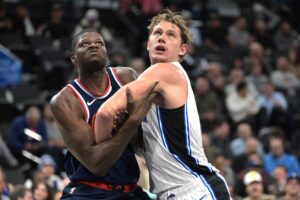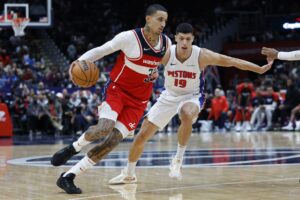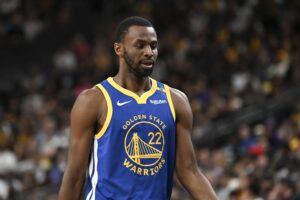Competitive balance among the NBA’s 30 teams has always been an issue for the league. Dating back to the 1960s, the Boston Celtics held a stranglehold over the rest of the Association. Led by Bill Russell, the C’s won ten titles in eleven seasons between 1959 and 1969, including eight straight. While that lack of parity hasn’t been seen since, the NBA still faces a challenging issue: the league’s few elite teams are that much better than the rest.
Let’s take the 2016-17 season for example. Since way back in the preseason, there’s been widespread consensus that the Golden State Warriors and Cleveland Cavaliers will meet in the Finals for a third consecutive year.
Sure, there are some dark-horse contenders like Houston, San Antonio, Boston, and even Toronto. But the Warriors’ and Cavaliers’ star-powered lineups position them as odds-on title favourites once again.
Being able to have a good idea of the NBA Finals matchup before the actual season starts is an issue. Sure, injuries and unpredictability can play a role, but the NBA is one league where shocking playoff upsets are rare. Only five eight-seeds have upset one-seeds since 1994. Two of those five upsets came in the old best-of-five first round series format. Given the lack of upsets and ease of early round matchups, the league’s best teams typically have an easier path to the Finals, especially in the weaker Eastern Conference. The main reason for that: the best teams have the most star players.
The NBA Relies on its Stars
Basketball is a sport where star players carry the majority of a team’s workload (Russell Westbrook this season and mid-2000s Kobe Bryant are prime examples of this). In the past 30 seasons, there has only been one NBA championship winner (’03-04 Detroit Pistons) that wasn’t headlined by one or multiple star players. Even then, one could argue Rasheed Wallace and Chauncey Billups were star players on that Pistons squad.
Here’s the proof:
- ’85-86 Celtics: Larry Bird, Kevin McHale, Robert Parish
- ’86-87, ’87-88 Lakers: Magic Johnson, James Worthy, Kareem Abdul-Jabbar
- ’88-89, ’89-90 Pistons: Isaiah Thomas, Joe Dumars
- ’90-91 to ’92-93, ’95-96 to ’97-98 Bulls: Michael Jordan, Scottie Pippen
- ’93-94 Rockets: Hakeem Olajuwon
- ’94-95 Rockets: Olajuwon and Clyde Drexler
- ’98-99 Spurs: David Robinson, (rookie) Tim Duncan
- ’99-00, ’00-01, 01-02 Lakers: Shaquille O’Neal, Kobe Bryant
- ’02-03, ’04-05, ’06-07 Spurs: Duncan, Tony Parker, Manu Ginobili
- ’05-06 Heat: Dwyane Wade, Shaquille O’Neal
- ’07-08 Celtics: Kevin Garnett, Paul Pierce, Ray Allen
- ’08-09, ’09-10 Lakers: Kobe Bryant, Pau Gasol
- ’10-11 Mavericks: Dirk Nowitzki
- ’11-12, ’12-13 Heat: LeBron James, Dwyane Wade, Chris Bosh
- ’13-14 Spurs: Kawhi Leonard, Tim Duncan, Tony Parker, Manu Ginobili
- ’14-15 Warriors: Stephen Curry, Klay Thompson, Draymond Green
- ’15-16 Cavaliers: LeBron James, Kyrie Irving, Kevin Love
Given how hard it is to acquire a star player, NBA competitiveness could remain unbalanced for the foreseeable future. A greater influx of star players and a change to the draft lottery system could help change that. We’ve already started to see the former, with multiple stars elevating their game this season. Despite the new wave of talent, though, these young stars don’t have enough talent around them to contend for championships. That brings us to the latter…
Incentive of Tanking
The NBA’s current draft lottery format encourages teams with little to no chance at winning a title to lose more, given teams with the worst records have a higher chance of picking higher in the NBA draft. If only six of the 30 NBA teams this season are considered title contenders, that means 80% of NBA teams are inclined to either tank, or remain in the league’s middle-ground; not good enough to contend, but also not bad enough to tank. That middle-ground is a place where no NBA team wants to be.
A team’s incentive to tank can also lead to veteran players being rested, which has been a hot topic of late. Look at the Los Angeles Lakers this season. The team will lose its first-round pick if it doesn’t fall within the top three of the upcoming draft. Because of this, the team has shut down expensive offseason acquisitions Luol Deng and Timofey Mozgov. While management can claim the two were shut down to give the team’s young players more opportunity, it’s obvious that benching them gives the Lakers a better chance at losing more games.
Revising the draft lottery could go a long way in helping fix the NBA’s competitive balance structure as we know it. Regardless of whether the draft lottery changes, though, the new CBA doesn’t help middle-of-the-pack teams at all. The agreement, which runs through 2024, could be a major roadblock for the NBA in its efforts to restore competitive balance in the future.
Main Photo
OAKLAND, CA – JUNE 19: LeBron James #23 of the Cleveland Cavaliers handles the ball against Stephen Curry #30 of the Golden State Warriors during the second half in Game 7 of the 2016 NBA Finals at ORACLE Arena on June 19, 2016 in Oakland, California. NOTE TO USER: User expressly acknowledges and agrees that, by downloading and or using this photograph, User is consenting to the terms and conditions of the Getty Images License Agreement. (Photo by Ezra Shaw/Getty Images)






